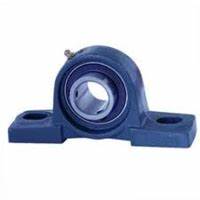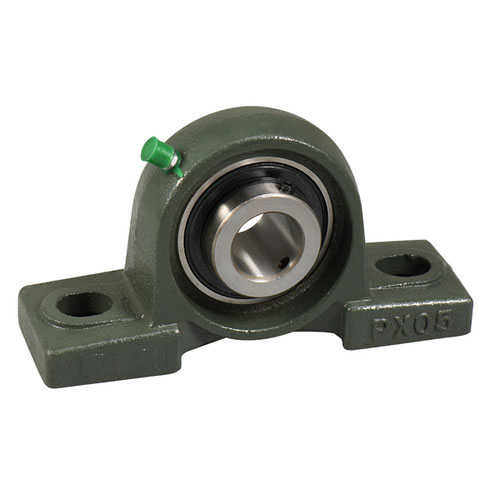Ball bearing units are a kind of rolling bearing. The spherical alloy steel ball is installed between the inner steel ring and the outer steel ring to reduce friction during the power transmission process and improve the transmission efficiency of mechanical power by rolling. Ball bearing units cannot withstand large, heavy loads and are more common in light industrial machinery.
Ball bearing units are generally used in low-load mechanical transmission equipment. Because the bearing area of the ball bearing is small, it is very easy to cause serious mechanical damage in the case of high-speed operation. Therefore, needle roller bearings are often used in heavy-load mechanical transmissions to increase the bearing surface, improve the mechanical transmission efficiency, and reduce mechanical damage.
The ball bearing units change the friction mode of the bearing and adopt rolling friction, which more effectively reduces the friction between the bearing surfaces, improves the service life of the fan bearing, and thus prolongs the service life of the radiator.
How do ball bearing units prevent rust?
From the manufacturer’s point of view
- In the production process of ball bearing units, according to the cleaning and anti-rust regulations and the oil seal anti-rust packaging requirements, the bearing parts and combined bearing products are subject to strict anti-rust treatment.
- The quality of products such as anti-rust lubricating oil and cleaning kerosene used in production must meet the technical requirements.
- The manufacturer’s anti-rust paper, nylon paper (bag), plastic tube, and other bearings should be packaged with the design material quality that should conform to the ball bearing units’ oil-sealed anti-rust packaging.

From the user’s point of view
- The humidity and temperature of the ball bearing units should be adjusted to appropriate values.
- Avoid scratches during use to prevent damage to the bearing surface.
- Substances such as sulfur dioxide and carbon dioxide produced by the smoke will cause corrosion of the parts, and a large amount of dust will cover the parts and become a corrosive medium, which is easy to rust.
- The oxygen system generated by the bearing during the storage management process can be dissolved in water. We can see the social phenomenon of corrosion due to the concentration difference of oxygen at any time, and the solubility of different parts will change. When the bearings are stacked, the oxygen is insufficiently inflated in the middle of the overlapping surface, the concentration in the water is low, the oxygen at the edge is sufficient, and the concentration in the water is high, and rust often occurs in the overlapping surface, affecting the surrounding urban edge components.
- The burns and cracks caused by pickling easily rust the cross roller bearing.
The difference between ball bearing units and roller bearings
Rolling bearings include both ball bearings and roller bearings. In the simplest terms, one rolling element is a ball, that is, a steel ball, and the other rolling element is a steel column. In general, the radial pressure bearing of roller bearings is better than that of ball bearings, but the speed is low.
Ball bearing units: a type of rolling bearing, the ball is installed in the middle of the inner steel ring and the outer steel ring, which can bear a large load. are also called deep groove ball bearings. Ball bearing units mainly contain four basic elements: balls, inner ring, outer ring, and cage. General industrial ball bearings meet the AISI52100 standard. The balls and rings are usually made of high-chromium steel with a Rockwell hardness of about 61–65. The hardness of the cage is lower than that of the ball and the ring, and its material is metal or non-metal. The rolling friction resistance of rolling bearings is smaller than that of journal bearings, so at the same speed, the temperature due to friction will be lower.

The rolling element is a radial rolling bearing with cylindrical rollers. Cylindrical rollers and raceways are linear contact bearings. Load capacity mainly bears radial load. The friction between the rolling element and the rib of the ring is small, which is suitable for high-speed rotation. According to whether the ring has ribs or not, there are NU, NJ, NUP, N, NF, and other single-row bearings, and NNU, NN double-row bearings. The bearing is a structure in which the inner ring and the outer ring can be separated. Cylindrical roller bearings without ribs on the inner or outer ring. The inner and outer rings can move relative to the axial direction, so they can be used as free-end bearings. Cylindrical roller bearings with double ribs on one side of the inner ring and outer ring and a single rib on the other side of the ring can withstand a certain degree of axial load in one direction. Generally, a steel stamping cage or a copper alloy turning cage is used. However, a portion of the use of polyamide forming cage.
Advantages of using ball bearing units
The metal ball movement belongs to the point of contact, so it is easy to activate the movement.
Can be used for portable products that are often operated at different placement angles and orientations (but prevent them from being thrown or dropped).
Longer service life (compared to oil-impregnated bearings).
Xiamen Smark Bearings is a professional pillow block flange bearing manufacturer. We have rich experience in production. Our factory was established in 1987, and now we are one of the largest exporters of pillow block flange bearings. Our main exporting countries include the United States, European countries, Asian markets, and Middle East markets. If you want to buy a tapered pillow block bearing, you are welcome to contact us.

